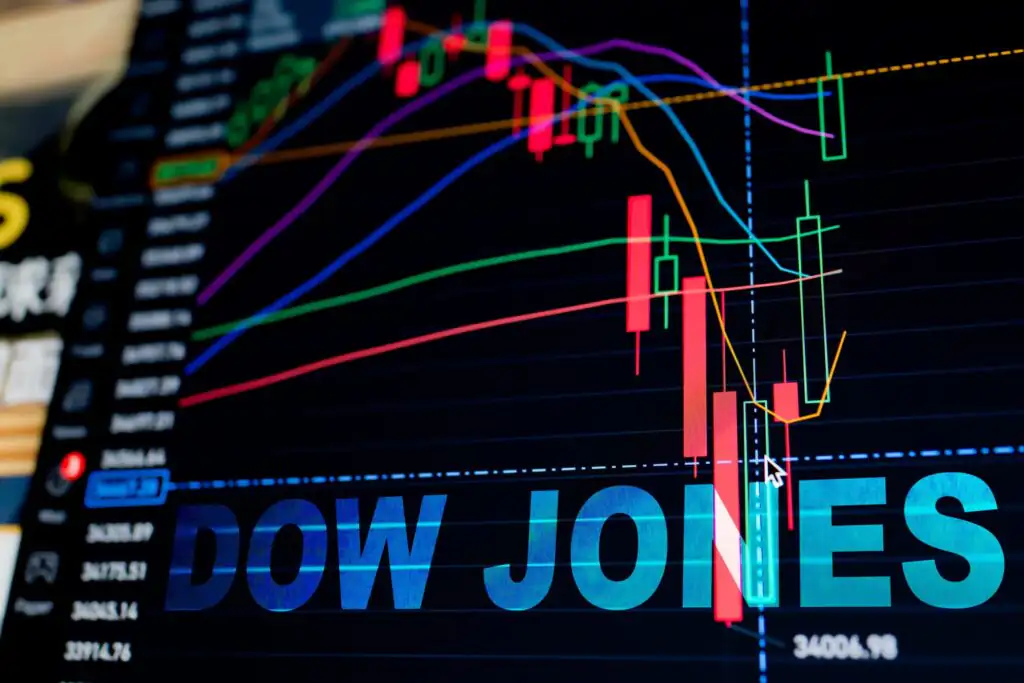The Dow Jones Industrial Average (DJIA), also known as the Dow, is one of the most widely followed stock market indexes in the world. It tracks the performance of 30 large-cap U.S. companies from various sectors and industries. The DJIA is often used as a benchmark for the overall health and direction of the U.S. economy. But what exactly is Indexdjx: .dji and how does it work?
In this article, we will explain the meaning, purpose, calculation, history, limitations, and comparison of the DJIA to other popular market indexes.
Understanding the Dow Jones Industrial Average (DJIA)
Definition and purpose
The DJIA is an index that measures the changes in the stock prices of 30 selected U.S. companies. The index was created in 1896 by Charles Dow, the founder of The Wall Street Journal, and Edward Jones, a statistician. The DJIA is one of the oldest and most influential stock market indexes in the world. The purpose of the DJIA is to provide a simple and easy way to track the performance of the U.S. stock market and the economy. The DJIA is also used as a proxy for investor sentiment and market expectations.
Calculation and index components
The DJIA is calculated by adding up the prices of the 30 stocks in the index and dividing by a divisor. The divisor is adjusted periodically to account for stock splits, dividends, and other corporate actions that affect the stock prices. The divisor as of November 10, 2023 was 0.151987075. The DJIA is a price-weighted index, which means that the higher-priced stocks have more influence on the index value than the lower-priced stocks. The DJIA is not a market capitalization-weighted index, which means that the size of the companies in the index does not affect the index value.
The 30 stocks in the DJIA are selected by the editors of The Wall Street Journal, in consultation with S&P Dow Jones Indices, the index provider. The selection criteria are not publicly disclosed, but the general principles are that the stocks should represent the U.S. economy, be widely held and traded, and have a history of growth and stability. The 30 stocks in the DJIA as of November 10, 2023 were:
| Company | Symbol | Sector | Industry |
|---|---|---|---|
| 3M Company | MMM | Industrials | Industrial Conglomerates |
| American Express Company | AXP | Financials | Consumer Finance |
| Amgen Inc. | AMGN | Health Care | Biotechnology |
| Apple Inc. | AAPL | Information Technology | Technology Hardware, Storage & Peripherals |
| Boeing Company | BA | Industrials | Aerospace & Defense |
| Caterpillar Inc. | CAT | Industrials | Construction Machinery & Heavy Trucks |
| Chevron Corporation | CVX | Energy | Integrated Oil & Gas |
| Cisco Systems, Inc. | CSCO | Information Technology | Communications Equipment |
| Coca-Cola Company | KO | Consumer Staples | Soft Drinks |
| Goldman Sachs Group, Inc. | GS | Financials | Investment Banking & Brokerage |
| Home Depot, Inc. | HD | Consumer Discretionary | Home Improvement Retail |
| Honeywell International Inc. | HON | Industrials | Industrial Conglomerates |
| IBM Corporation | IBM | Information Technology | IT Consulting & Other Services |
| Intel Corporation | INTC | Information Technology | Semiconductors |
| Johnson & Johnson | JNJ | Health Care | Pharmaceuticals |
| JPMorgan Chase & Co. | JPM | Financials | Diversified Banks |
| McDonald’s Corporation | MCD | Consumer Discretionary | Restaurants |
| Merck & Co., Inc. | MRK | Health Care | Pharmaceuticals |
| Microsoft Corporation | MSFT | Information Technology | Systems Software |
| Nike, Inc. | NKE | Consumer Discretionary | Footwear |
| Procter & Gamble Company | PG | Consumer Staples | Household Products |
| Salesforce.com, Inc. | CRM | Information Technology | Application Software |
| The Travelers Companies, Inc. | TRV | Financials | Property & Casualty Insurance |
| UnitedHealth Group Incorporated | UNH | Health Care | Managed Health Care |
| Verizon Communications Inc. | VZ | Communication Services | Integrated Telecommunication Services |
| Visa Inc. | V | Information Technology | Data Processing & Outsourced Services |
| Walgreens Boots Alliance, Inc. | WBA | Consumer Staples | Drug Retail |
| Walmart Inc. | WMT | Consumer Staples | Hypermarkets & Super Centers |
| Walt Disney Company | DIS | Communication Services | Movies & Entertainment |
| Exxon Mobil Corporation | XOM | Energy | Integrated Oil & Gas |
Historical milestones
The DJIA has a long and rich history of reflecting the ups and downs of the U.S. stock market and the economy. Some of the notable historical milestones of the DJIA are:
- The DJIA was first published on May 26, 1896, with a value of 40.94.
- The DJIA reached its first 100-point milestone on January 12, 1906, with a value of 100.25.
- The DJIA reached its first 1,000-point milestone on November 14, 1972, with a value of 1,003.16.
- The DJIA reached its first 10,000-point milestone on March 29, 1999, with a value of 10,006.78.
- The DJIA reached its first 20,000-point milestone on January 25, 2017, with a value of 20,068.51.
- The DJIA reached its first 30,000-point milestone on November 24, 2020, with a value of 30,046.24.
- The DJIA reached its all-time high of 35,679.13 on August 16, 2021.
Limitations and Criticisms of the DJIA
Despite its popularity and prestige, the DJIA has some limitations and criticisms as a measure of the U.S. stock market and the economy. Some of the main issues are:
Issues with market representation
The DJIA only tracks 30 stocks, which is a very small sample of the thousands of publicly traded companies in the U.S. The DJIA does not include many important sectors and industries, such as utilities, real estate, consumer services, and transportation. The DJIA also does not reflect the performance of small-cap and mid-cap companies, which may have different growth and risk characteristics than large-cap companies. The DJIA is not a comprehensive or representative indicator of the U.S. stock market or the economy.
Correlation among components
The 30 stocks in the DJIA are not independent of each other. They may have similar exposure to the same economic factors, such as interest rates, inflation, exchange rates, consumer demand, and geopolitical events. They may also have overlapping business activities, such as supply chain, distribution, and competition. The correlation among the components reduces the diversification and risk-adjusted return of the DJIA. The DJIA may not capture the true volatility and diversity of the U.S. stock market or the economy.
Comparison to Other Indexes
The DJIA is not the only index that tracks the U.S. stock market or the economy. There are many other indexes that have different methodologies, compositions, and objectives. Some of the most popular and widely used indexes are:
How the Dow differs from the S&P 500
The S&P 500 is an index that tracks the performance of 500 large-cap U.S. companies from various sectors and industries. The S&P 500 is a market capitalization-weighted index, which means that the larger the company, the more weight it has in the index. The S&P 500 is considered to be a more accurate and representative measure of the U.S. stock market and the economy than the DJIA. The S&P 500 covers about 80% of the total U.S. stock market value, while the DJIA covers about 25%. The S&P 500 also has a lower correlation among its components than the DJIA, which means that it has more diversification and risk-adjusted return. The S&P 500 is more widely used by investors, analysts, and media as a benchmark and reference point than the DJIA.
Other popular market indexes
There are many other market indexes that track different segments, sectors, and styles of the U.S. stock market and the economy. Some of the most popular and widely used ones are:
- The Nasdaq Composite Index, which tracks the performance of over 3,000 companies listed on the Nasdaq stock exchange, mainly from the technology, biotechnology, and consumer sectors. The Nasdaq Composite is a market capitalization-weighted index, which means that the larger the company, the more weight it has in the index. The Nasdaq Composite is considered to be a leading indicator of the innovation and growth of the U.S. economy.
- The Russell 2000 Index, which tracks the performance of 2,000 small-cap U.S. companies from various sectors and industries. The Russell 2000 is a market capitalization-weighted index, which means that the smaller the company, the less weight it has in the index. The Russell 2000 is considered to be a proxy for the domestic and entrepreneurial aspects of the U.S. economy.
- The Wilshire 5000 Total Market Index, which tracks the performance of over 3,500 companies from the U.S. stock market, covering almost all of the publicly traded companies in the U.S. The Wilshire 5000 is a market capitalization-weighted index, which means that the larger the company, the more weight it has in the index. The Wilshire 5000 is considered to be the most comprehensive and diversified measure of the U.S. stock market and the economy.
Conclusion
The Dow Jones Industrial Average (DJIA), or Indexdjx: .dji, is one of the most famous and influential stock market indexes in the world. It tracks the performance of 30 large-cap U.S. companies from various sectors and industries. The DJIA is often used as a proxy for the U.S. economy and investor sentiment. However, the DJIA has some limitations and criticisms, such as its lack of market representation, its price-weighting methodology, and its correlation among components. The DJIA is not the only index that measures the U.S. stock market and the economy. There are many other indexes that have different methodologies, compositions, and objectives, such as the S&P 500, the Nasdaq Composite, the Russell 2000, and the Wilshire 5000. These indexes provide different perspectives and insights into the U.S. stock market and the economy. Investors and analysts should be aware of the strengths and weaknesses of each index and use them accordingly.



